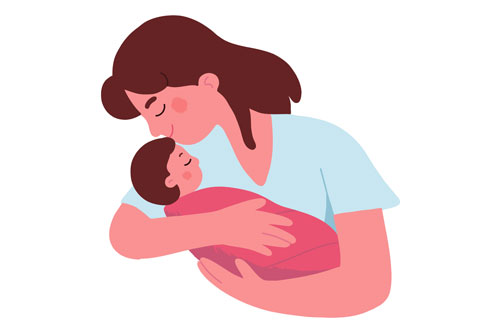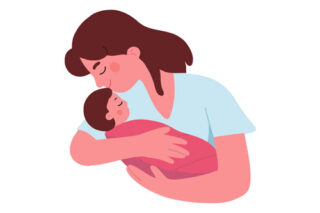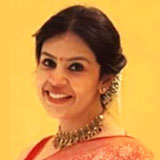Delayed Motherhood? Your Breast Cancer Risk Just Shot Up: Act Now!

Delayed Motherhood? Your Breast Cancer Risk Just Shot Up: Act Now!
Dr. Swati Shah
India’s Leading Breast Imaging Expert
 You broke glass ceilings, congrats! But is your health paying the price?
You broke glass ceilings, congrats! But is your health paying the price?
If you’re a woman balancing deadlines with dinner plans and had your first child in your late 30s, this blog is for you.
New research shows that delayed motherhood can significantly increase your breast cancer risk. No, this isn’t fearmongering. It’s science.
Women who have their first baby after 35 face a much higher breast cancer risk. It could be more than double compared to women who had their first child in their 20s. What’s more striking is that these late mothers face 18% more breast cancer risk than even those who never had children at all.[1]
Why does late motherhood increase breast cancer risk?
- Early pregnancy matures the breast cells early, reducing lifetime exposure to fluctuating estrogen.
- Delayed childbirth means your breast tissue remains more vulnerable for longer.
- The risk multiplies with high stress, irregular sleep, and urban lifestyle.
Don’t let the myths blind you.
Despite strong medical evidence linking late motherhood to breast cancer risk, deeply rooted cultural myths and modern misconceptions may stop you from acting in your true interest.
Let’s bust the most common and dangerous myths — so you can protect yourself with facts, not fear or ignorance.
- Myth: “It’s perfectly normal to delay kids these days – times have changed”
Fact: Social norms may have changed. But your biology hasn’t. Speak to your doctor early about your reproductive health and timelines. - Myth: “I eat healthy and go for walks, I’m not at risk.”
Fact: A healthy lifestyle helps, but hormones and other risk factors matter too. Delayed childbirth affects your hormones, regardless of fitness. - Myth: “I have no family history, so I’m safe.”
Fact: 80% of breast cancers occur in women with no family history. - Myth: “I feel fit and fine. No symptoms either. So, I am healthy.”
Fact: Early breast cancer is often silent. By the time you feel symptoms, it may already be too late. - Myth: “I regularly check with self-breast exams. I am safe”
Fact: Self-exams can miss early tumours, which could be too small or deep to be felt by even a doctor’s trained hands. The hands generally feel a lump only after the tumour has grown big, which could mean a more aggressive treatment and reduced chances of survival. Hence, routine mammograms are recommended by the world’s most medical organisations for breast cancer screening. - Myth: “Mammograms are painful and harmful.”
Fact: They are quick, safe, and life-saving.
The best defence? Lifestyle planning & routine mammograms
- Lifestyle planning around motherhood cuts your breast cancer risk.
- Understand how fertility changes with age. Talk to your gynaecologist now, even if you plan to start a family later.
- Avoid waiting for the ‘perfect time’. Discuss the risks with your partner and doctor.
- Explore flexible parenting, hybrid roles, and work-from-home options. Talk to women who have managed both kids and work successfully without delayed motherhood.
- Start annual mammograms early if you had your first kid after 35, after consulting your radiologist.
- Routine annual mammograms: A lifesaving habit.
- No one can prevent breast cancer, but breast cancer caught early (stage 1) is 99% curable.[2] On the contrary, late detection drastically reduces survival chances. So, don’t wait for symptoms—get screened annually!
- Mammography, mainly 3D mammography, is the most reliable way to detect breast cancer early – before it can be felt with hands. Unlike conventional 2D mammograms, which take flat images of your breast tissue, 3D mammography takes multiple pictures from different angles, providing a more detailed view. This enables radiologists to identify subtle, early changes that a self-exam or 2D mammogram may miss.
- 3D mammography is far superior to 2D scans, especially in women with dense breasts (common among Indians).
Why 3D mammography is a game changer
Here’s how the latest 3D mammography outshines the earlier versions to keep you safer:
- Enhanced clarity: It provides detailed, three-dimensional images, making it easier to detect small tumors by using innovative technology designed to produce clear images of the breast tissue, layer by layer.[3]
- Reduced recalls: 3D mammography exams help considerably reduce recall rates for additional tests.[4]
- Better detection: 3D mammography exams enable the detection of more cancer cells[5], and 20–65% more invasive breast cancers than 2D alone, with an average increase of 41%.[6]
- Helps high-risk women more: 3D mammography is beneficial in high-risk women, i.e., including those with:
- Changes or lumps in the breasts
- A family history of breast or ovarian cancer[7]
- Dense breast tissue (nearly half of all women above the age of 40 have dense breasts)[8]
- A previous diagnosis of breast disease
This means two simple things: Earlier detection than ever before and less anxiety about unnecessary further testing.[9]
Routine mammograms often yield reassuring news that ‘all is well.’
In Conclusion:
Understanding the dreadful consequences of late breast cancer diagnosis can empower you to stay breast-healthy. Here are some general tips for your action:
- Never miss your healthy diet, daily exercise, and annual mammogram: Both your healthy lifestyle and yearly mammograms are vital. Mammograms can detect breast cancer early when it is most treatable. Don’t rely on breast self-exams or other modalities. Make it a priority to schedule your yearly screening even if you feel perfectly healthy.
- Select the right mammography center: You may have several options available to you for getting a mammogram, such as a diagnostic lab, a hospital, or a dedicated breast clinic. How do you choose one among all the available options? Here are three easy steps to help you choose the right mammography center.
- Overcome your mammography anxiety if you have any: If you feel anxious before a mammography session, you are not alone. Your stress could be due to either it being your first mammogram, your fear of discovering cancer, myths harboured in your mind, or your past uncomfortable experience. Whatever your reason, it’s important to remember that mammograms save lives, and here are seven tips to help you relax before your next mammogram.
- Stay informed. Stay healthy: Your family needs you forever. Your health is as important to them as it is to you. Keep up with the latest research and reliable information on mammography and breast health. Follow healthy routines and medical advice to protect yourself and your loved ones.
- Get your mammogram today: Early detection is the best defence against breast cancer. 3D mammography gives you the best chance of catching breast cancer early when it’s most treatable. So, don’t wait or rely solely on self-exams. If you are eligible for breast screening either by age (40 years and above) or due to high-risk factors such as family history (in which case even if you are younger than 40 years), subscribe today to an annual screening mammography plan at a center near you and never miss your test—a simple ritual that can save your life!
It’s not just about you – it’s about always being there for your loved ones.
Take charge of your health and encourage other women to do the same.

Dr. Swati Shah
MD, DNB
Consultant (Breast and Body Imaging Division)
Star Imaging and Research Centre, Pune
- Zhu JW, Charkhchi P, Adekunte S, Akbari MR. What Is Known about Breast Cancer in Young Women? Cancers. 2023; 15(6):1917. https://doi.org/10.3390/cancers15061917
- Giaquinto AN, Sung H, Miller KD, et al. Breast Cancer Statistics, 2022. CA: A Cancer Journal for Clinicians. 2022;72(6). doi: https://doi.org/10.3322/caac.21754
- Friedewald SM, Rafferty EA, Rose SL, Durand MA, Plecha DM, Greenberg JS, Hayes MK, Copit DS, Carlson KL, Cink TM, Barke LD, Greer LN, Miller DP, Conant EF. Breast cancer screening using tomosynthesis in combination with digital mammography. JAMA. 2014 Jun 25;311(24):2499-507. doi: 10.1001/jama.2014.6095. PMID: 25058084. https://pubmed.ncbi.nlm.nih.gov/25058084/
- Rose SL, Tidwell AL, Bujnoch LJ, Kushwaha AC, Nordmann AS, Sexton R Jr. Implementation of breast tomosynthesis in a routine screening practice: an observational study. AJR Am J Roentgenol. 2013 Jun;200(6):1401-8. doi: 10.2214/AJR.12.9672. PMID: 23701081. https://pubmed.ncbi.nlm.nih.gov/23701081/
- Skaane, Per, et al. “Comparison of digital mammography alone and digital mammography plus tomosynthesis in a population-based screening program.” Radiology 267.1 (2013): 47-56. https://pubs.rsna.org/doi/full/10.1148/radiol.12121373
- Friedewald SM, Rafferty EA, Rose SL, Durand MA, Plecha DM, Greenberg JS, Hayes MK, Copit DS, Carlson KL, Cink TM, Barke LD, Greer LN, Miller DP, Conant EF. Breast cancer screening using tomosynthesis in combination with digital mammography. JAMA. 2014 Jun 25;311(24):2499-507. doi: 10.1001/jama.2014.6095. PMID: 25058084. https://pubmed.ncbi.nlm.nih.gov/25058084/
- https://www.canceraustralia.gov.au/sites/default/files/publications/breast-cancer-risk-factors-review-evidence/pdf/rfrw-breast-cancer-risk-factors-a-review-of-the-evidence_1.15.pdf accessed 30 Nov 2024
- https://www.cancer.gov/types/breast/breast-changes/dense-breasts accessed 30 Nov 2024
- Zuley ML, Bandos AI, Ganott MA, Sumkin JH, Kelly AE, Catullo VJ, Rathfon GY, Lu AH, Gur D. Digital breast tomosynthesis versus supplemental diagnostic mammographic views for evaluation of noncalcified breast lesions. Radiology. 2013 Jan;266(1):89-95. doi: 10.1148/radiol.12120552. Epub 2012 Nov 9. PMID: 23143023; PMCID: PMC3528971. https://pubmed.ncbi.nlm.nih.gov/23143023/
